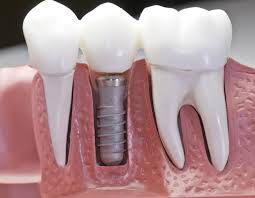DENTAL practitioners have tried to develop artificial teeth to be placed in the jawbones since the origin of dentistry.
In relatively recent years, however, there has been increased activity in the area of implant dentistry. Dental implants were actually initiated by Swedish research in the 1960s. The placement of small titanium cylinders or screws into the jawbone has progressed from experimental (and highly criticised) to common usage by many dentists.
The titanium-screw concept popularised implant use although other types of implants were available much earlier. Examples are blades placed into the jawbone, with heads protruding above the gums, and sub-periosteal implants placed on top of the bone and gums.
Do these tooth substitutes (dental implants) work? Yes, they do! In fact, I do believe and hereby predict that years after I would have passed on, the procedure would become far more common than root canal therapy. In numerous situations their ability to function rivals that of natural teeth. In severe cases they have allowed persons unable to wear traditional artificial dentures to chew well and appear normal. The most popular current concept (cylinders and screws) requires two clinical sessions.
1. The gum tissue is opened, and the screw like titanium implant is placed into the bone. This implant combines with the bone as the bone cells grow into its surface. This process, which has been called osseointegration, takes several months. During this time, the implant is usually sealed below the gum, away from mouth fluids and debris, while it heals into place.
2. A small hole is made in the gum tissue, and the implant is exposed. A healing cap is placed on the implant for a short time, and a head is placed onto the implant body. The gum tissue heals for a short time, and the dentist places some artificial teeth (prosthesis) onto the implant(s). These artificial teeth can be made to appear and function as well as or better than natural teeth.
Do all dentists provide implants? No. There are two distinct divisions in the implant procedure described. The placement of the implant into bone is a surgical procedure performed by oral and maxillofacial surgeons, periodontists, prosthodontists, and some general dentists. As a general dentist I do implants having done three courses, one in Trinidad and two in the United States. The point is that it is not difficult to perform so one does not necessarily have to be a specialist.
If your general dentist does not provide this service, he or she will refer you to a practitioner who performs the surgical portion of the procedure. The second portion, or attachment of artificial teeth (prosthesis) onto the implant(s), is usually accomplished by prothodontists or general dentists. Both portions of the implant procedure are exacting techniques requiring training.
If implants are so good, why is it that more persons are not requesting them instead of the other available options? The answer is simple. Due to the nature of implants, the process has a significant potential of being less predictable than desired depending on factors inherent in the patient’s biological/genetic presentation. This is apart from the fact that the procedure is more protracted.
Now, implants are expensive, and, as with natural teeth, require upkeep by patients and dentists. When implants are really needed, they do not have objective satisfactory substitutes. The task for you and your dentist is to determine whether your oral needs would be served best by using dental implants to replace the root structure of the natural teeth, followed by some form of prosthesis (artificial replacement) for the missing tooth structures. Total and comprehensive case assessment is important for success.
Dr. BERTRAND R. STUART DDS.



.jpg)









